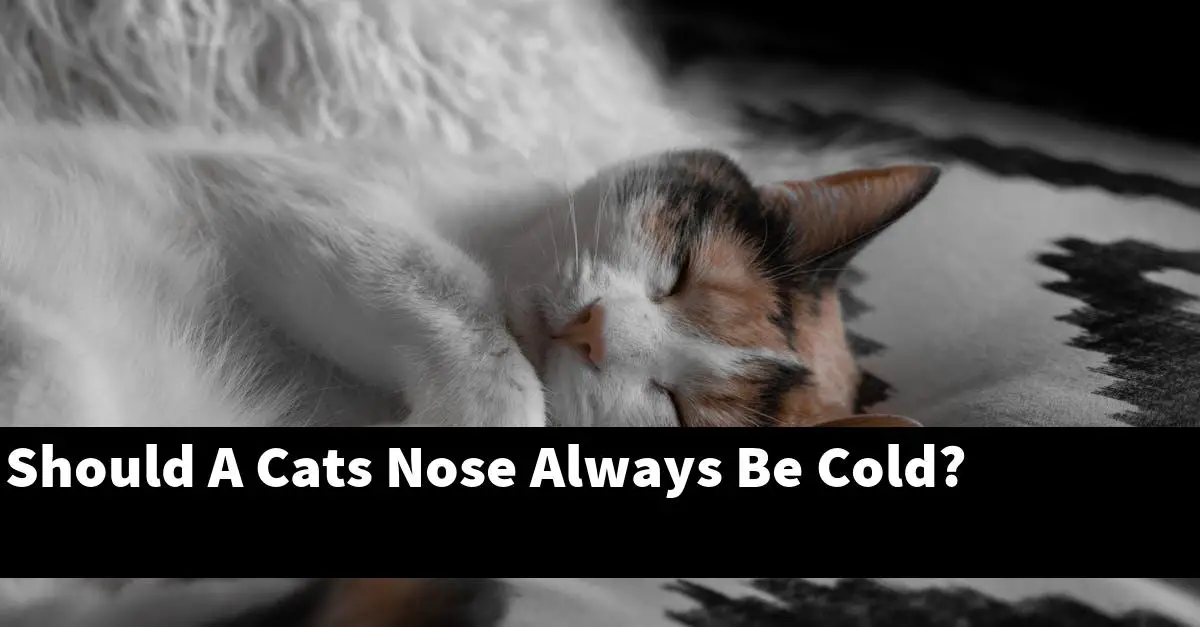No, a cat’s nose does not always have to be cold. However, if a cat’s nose is warm, it may be a sign of illness.
Is it bad if my cat’s nose is cold?
It depends on the individual cat’s needs and behavior. Some cats may prefer their noses to be cold, while others may not be as bothered by it.
If your cat seems to be uncomfortable, it may be best to give her a warm bath or to put a warm, soft towel over her head.
What temperature should a cat’s nose be?
A cat’s nose should be kept at a temperature between 68 and 74 degrees Fahrenheit. This is to ensure that their respiratory system is functioning properly and that they do not get sick.
Why are cats noses always cold?
Cats have a lot of fur on their bodies, which helps them keep warm. However, when they go outside, their noses get cold very quickly.
Their noses are very sensitive to temperature, and the cold air makes their noses cold.
Should cats noses be cold and wet?
Cats typically have cold noses because they are in a state of “shock and awe” when they see people or other animals for the first time. This is because they are in a state of fear, and their body is trying to keep them warm.
The wet nose is another defense mechanism. When a cat smells something, the mucous membranes in their nose become wet.
This helps them to absorb more scent.
What does a healthy cat nose feel like?
A healthy cat nose should not feel dry or cracked. It should also have a pleasant smell.
If the cat has a cold, the nose may be runny or have a slight cough.
Should cats have warm or cold noses?
It depends on the individual cat’s physiology and lifestyle. Some cats may prefer warm noses while others may prefer cold noses.
Some cats may even have noses that are both warm and cold. Some cats may even have noses that are either warm or cold all the time.
Ultimately, it is up to the individual cat to decide what type of nose they prefer.
How can you tell if cat has fever?
A fever is typically a body temperature above 96 degrees Fahrenheit. However, a fever can also be a sign of another illness.
To determine if a cat has a fever, you can take their temperature using a thermometer. If the temperature is above the normal range for the cat’s breed or age, the cat may have a fever.
If the temperature is not within the normal range for the cat’s breed or age, then the cat may not have a fever.
How can you tell when a cat is dehydrated?
A cat that is dehydrated is generally more lethargic and may have a decreased appetite. The skin may be dry and have a dull appearance, and the cat may have difficulty concentrating or walking.
The cat may also have a decreased urination and defecation rate, and a decreased thirst and appetite. In severe cases, the cat may have seizures, collapse, or death.
How do I know if cat has fever?
There are a few ways to determine if a cat has a fever. The most common way is to use a thermometer to measure the cat’s temperature.
Other ways to determine if a cat has a fever are to look for changes in behavior, look for changes in the cat’s coat, and to palpate the cat’s body.
How can you tell if a cat is healthy?
There are a few ways to determine whether a cat is healthy:
-A veterinarian can perform a physical exam and check for any health issues.
-A veterinarian can run a health check on a sample of the cat’s blood.
-A home veterinarian can run health checks on cats using a variety of tests, including a fecal test, a heartworm test, and a urinalysis.
Does a wet nose mean a cat is hydrated?
A wet nose often indicates that a cat is hydrated. The moisture on the cat’s nose helps to cool the cat’s body temperature.
Are cats ears supposed to be cold?
Some people believe that cats’ ears should be cold because cats are able to move their ears and warm them up quickly. Other people believe that cats’ ears should not be cold because it can be uncomfortable for the cat.
Conclusion
Each cat’s individual metabolism can cause their nose to be warm or cold. However, if a cat’s nose is suddenly very warm or hot, this could be indicative of a fever and should be checked by a veterinarian.


